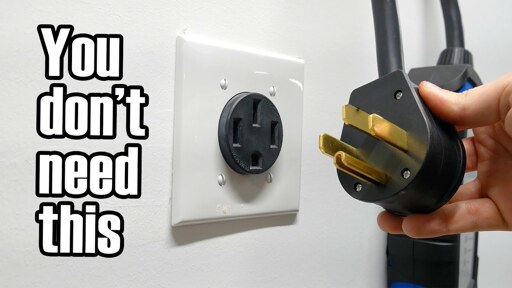My wife had to try charging on a 120V outlet last winter. The plug couldn’t even keep up with the battery heating requirements to actually start charging; the battery percentage was going DOWN while plugged in. It was -25°C outside though, so it’s a specific situation, but it’s actually why she had to try to charge; it’s a trip we can easily do without charging in the summer.
Car specific maybe? I was able to charge at -30C outside from a 120V outlet last winter.
Maybe, I know Teslas are a bit power-hungry when parked.
I agree with this youtube comment:
As an electrician (in Australia), I agree with your basic premise. However, if you are asking me to install an EV charger, unless you tell me “I want it to charge slowly with a limited current capacity”, I am going to assume it is to charge an EV under ALL situations - fast to slow, for whoever may drive one today or in the future, even with a potential new homeowner. We generally do our work with the priority order (1) safety - nobody gets an electric shock and nothing catches fire; (2) avoidance of nuisance i.e. the thing you just installed doesn’t work and keeps tripping the breaker 😑 (3) avoiding needing replacement electrical work for at least 25 - 50 years
Also I live in a townhouse with no garage. Our charger is between the neighborhood sidewalk and our parking spaces, so I’d prefer keeping it plugged in as little as possible to minimize any issues with foot traffic (neighbors, delivery people, garbage pickup, etc). I’ve seen other townhouse EV owners literally run an extension cable over the sidewalk to do an L1 charge for their EV and that’s just asking for trouble.
He did say that it’s different if you don’t own your own garage or live in a townhouse
In recent test of a German auto club they found out that it‘s cheaper/ more effective to charger faster. You loose a lot of energy if you load slow over hours.
This energy is taken by the electricity of the car. So, while charging the car is on and takes some Watts. There are just a few brands that have decoupled the charger circuit from the overall electric circuit of the car.
Can’t find the article now, but I think charging a PHEV through a standard power plug had about 20% energy lost. It was clearly visible that a charger is a good choice.
You‘ll loose
- ~10-30% AC 2.3kw Standard Power Plug
- ~ 5-10% DC 11kw Wallbox
- Internal car electronics are crucial: Is the loading circuit de-coupled or the entire car On?
- Temperature or pre-heating the battery before loading reduces losses at DC charging
Did that account for battery lifetime, because if not, that could offset efficiency gains as fast charging degrades batteries.
Any AC load you can throw at an EV is effectively “slow charging”. My car supports a maximum of 9.6kw from an AC charger, but up to 150kw from DC fast chargers. Even with the fast charging, its not like a phone, it has active thermal management which will cool the battery and slow down the charging if it gets too hot. phones don’t really have that and is mainly why they degrade faster if quick charged.
Can you source that?
Here is a paper on the relationship between heat and battery degradation
Watts/h
Just watts, watts is already Joules per second.
Yes, he responds to that in the video.
I watched the video and it seems to make good points, but no matter how many times I see something related to US power circuits it just feels so … antique? I have 3x25A fuses on the house and several 3x16A outlets around so getting 11kW out is just a matter of plugging in a socket.
Obviously it would be a good thing to have controls so that water heater, floor heating or sauna stove aren’t all on together but I think I’ve replaced a single 25A fuse over 10 years we’ve lived on this house and I’m pretty sure that was caused by a small(ish) surge on the grid and not our load.
Fuses sound antique compared to resettable circuit breakers. Though, if I remember correctly, your outlets have resettable breakers? Anyway, part of the wattage deficiency comes from the voltage being half of Europe’s. The wires are similarly sized so they hit about the same max amperage (largely 15a for most circuits, 20a frequently in kitchens/garages/exterior outlets, 100-250a main breaker for the house) but halving the voltage halves the wattage available
It’s not fucking overkill. There’s no such thing.
I’m really disappointed with the video. That dude usually knows his shit, but he’s way off the mark here. It’s just plain wrong.
Getting a smaller charger might save a few hundred, but it will also increase your chances of burning the house down. Good fucking advise, huh.
Fuck that. You’ll always want to charge as fast as your main circuit breaker will allow.
Yeah, running a 240V 50A outlet in a garage in most homes would be fairly cheap, since it’s usually not going very far from the main panel. So might as well do it if you’re already spending a huge chunk of change on an electric car.
The last time we hired an electrician to run about 30 feet from a panel to a new 50A sub-panel across the shop for a project was around $800 IIRC.
I don’t disagree with this, but we have a detached garage and got quoted over $6k to retrench an upgraded line to it. I know he mentioned this condition in the video, but our driveway is so tight it would be an obstacle to put a charger just on the outside of the house.
In the meantime, we started using a regular outlet in the garage with the basic charger that came with our Ioniq and after 2 years have never needed anything more. Never even used a public charger.






